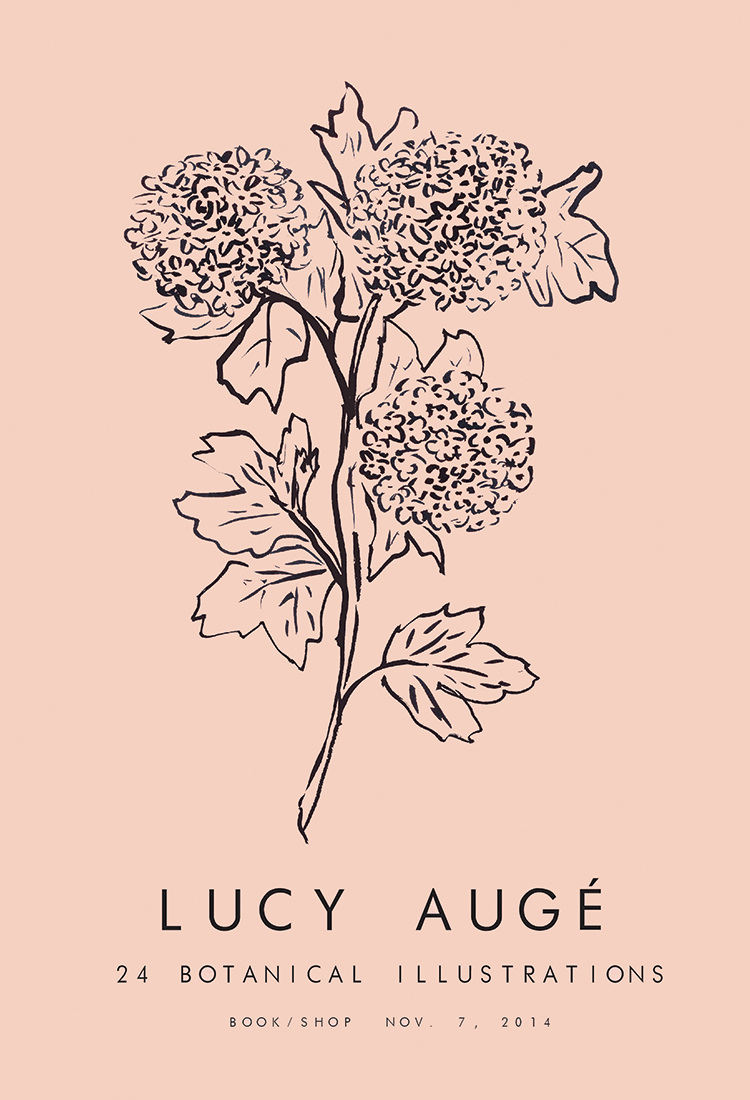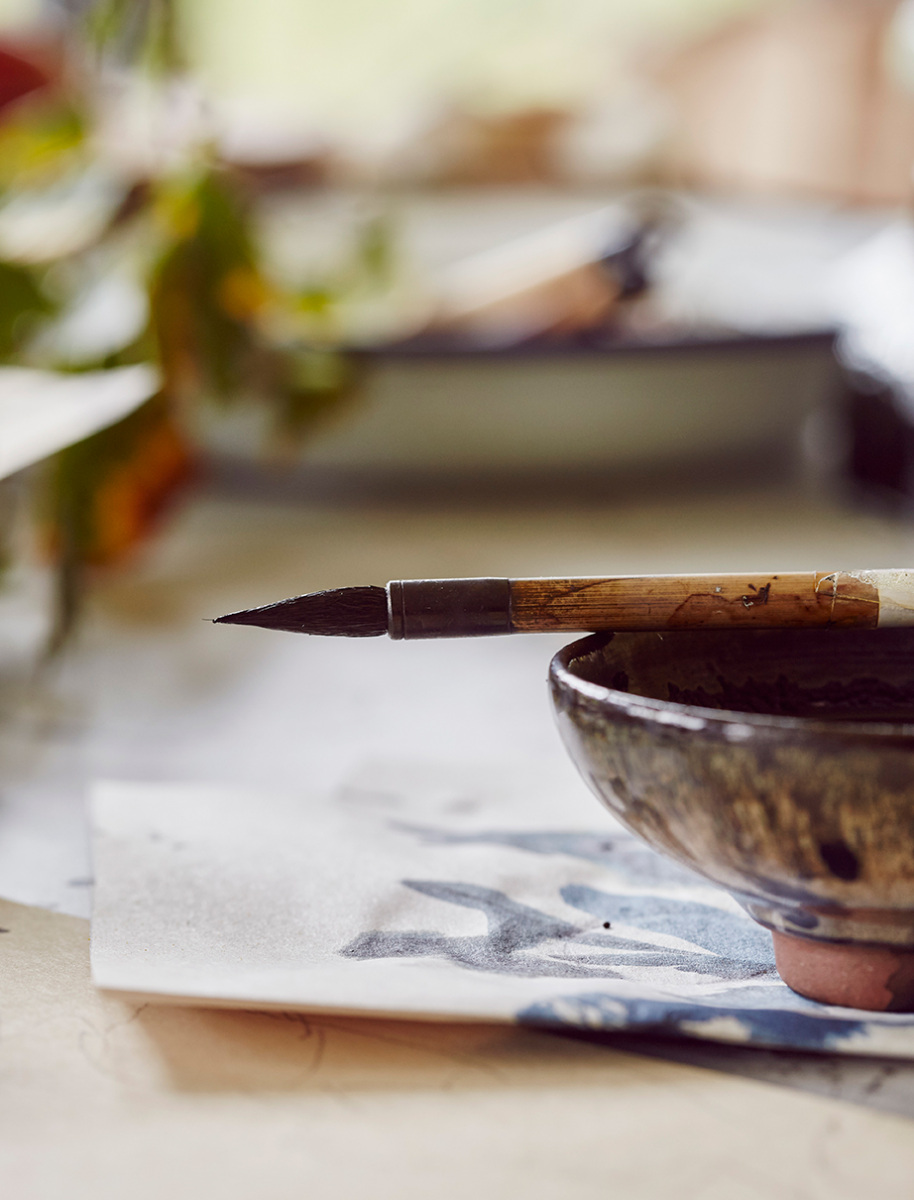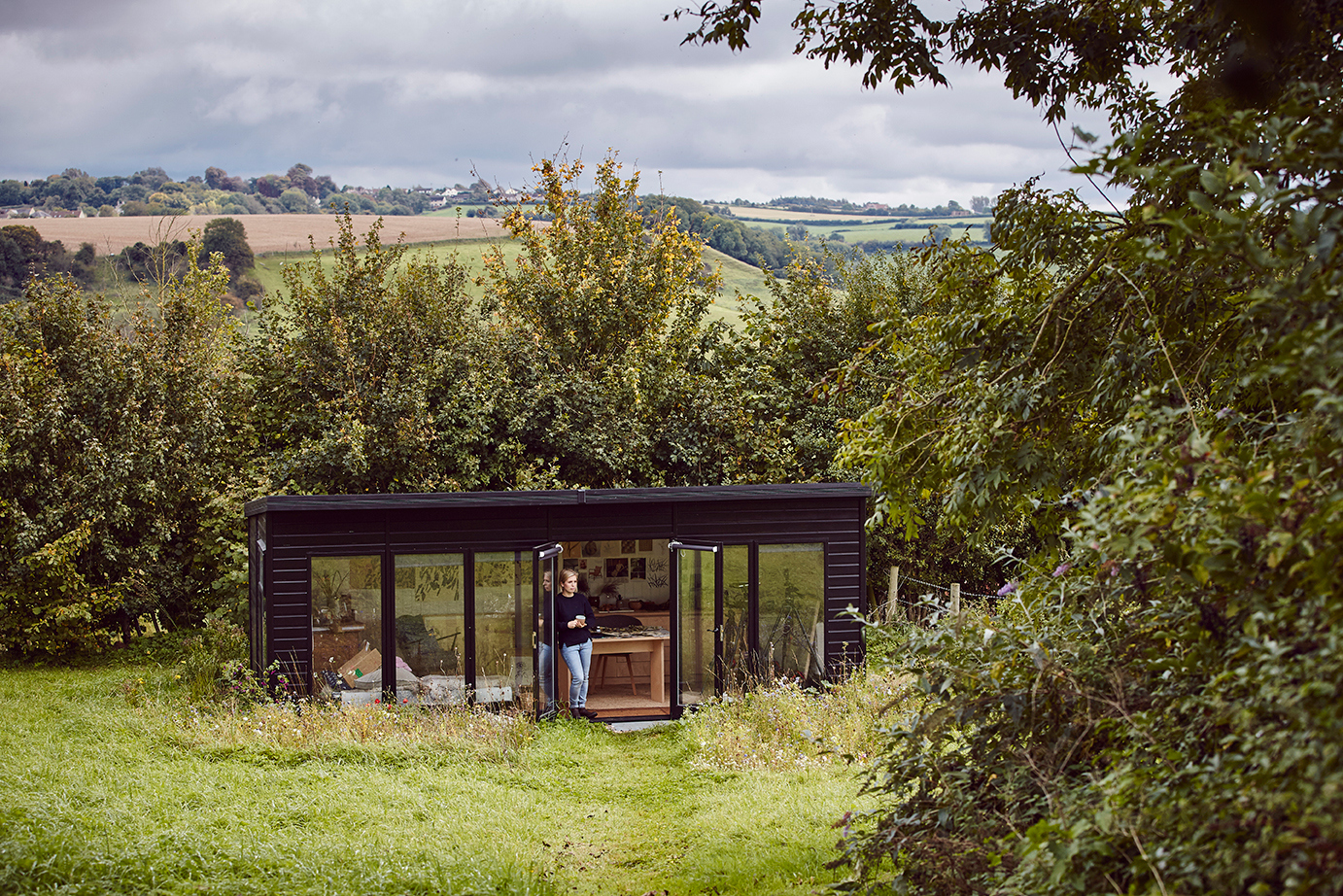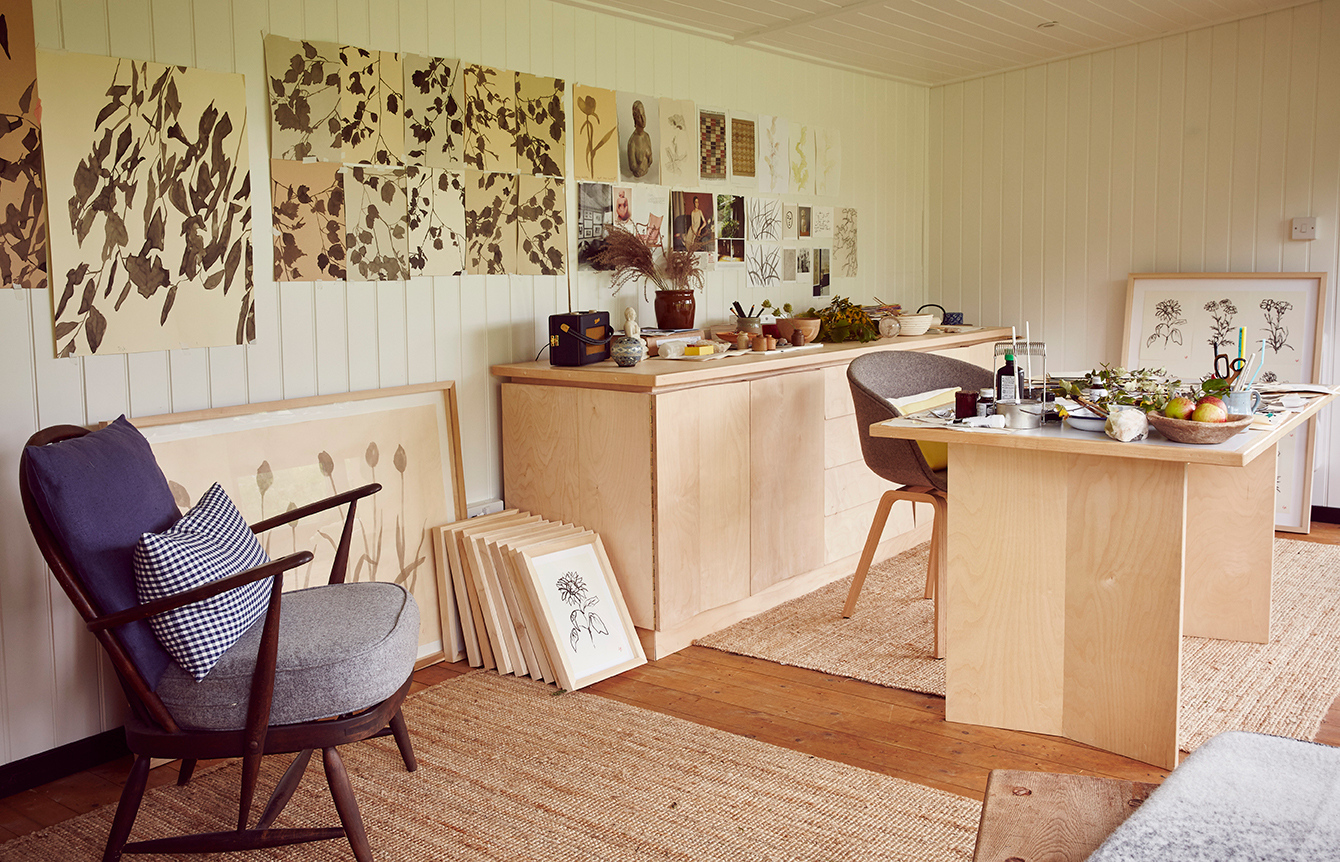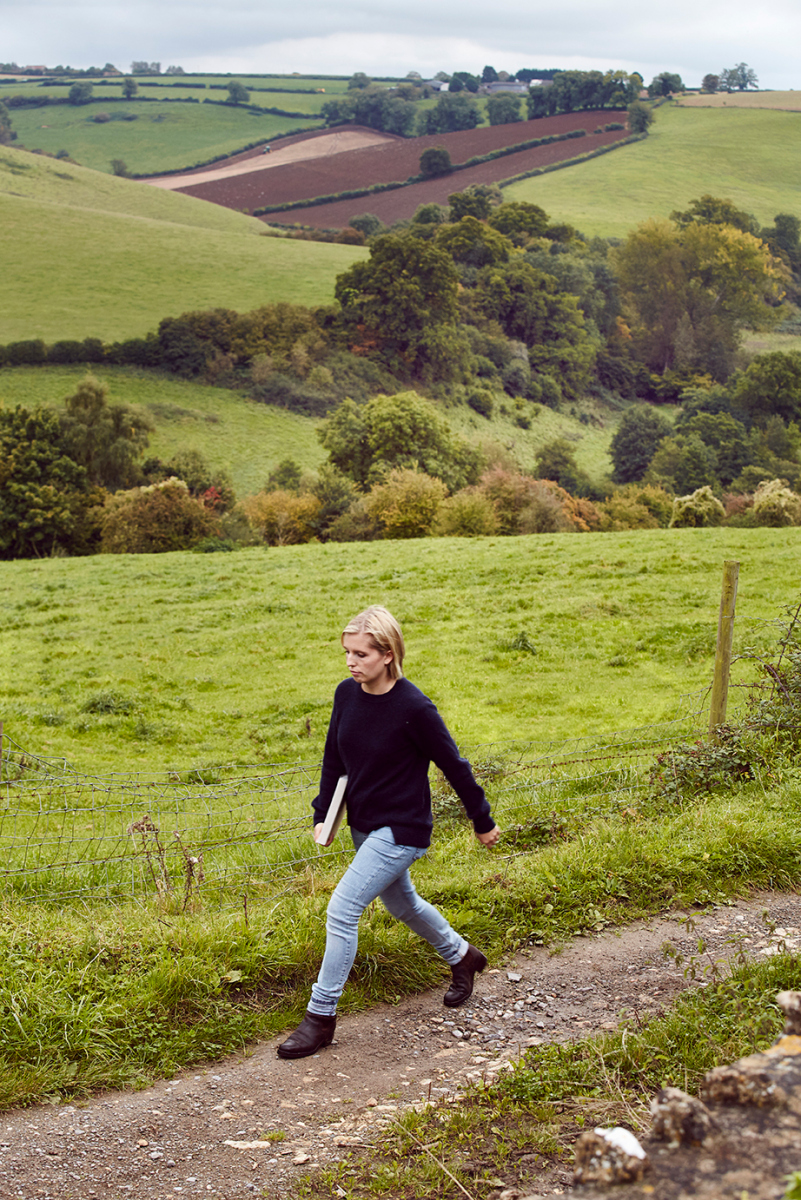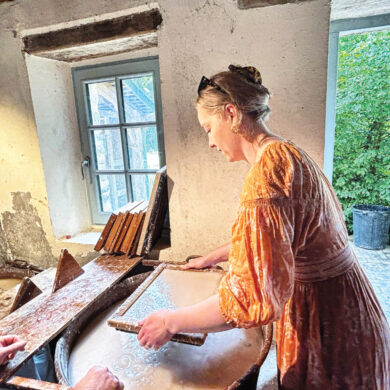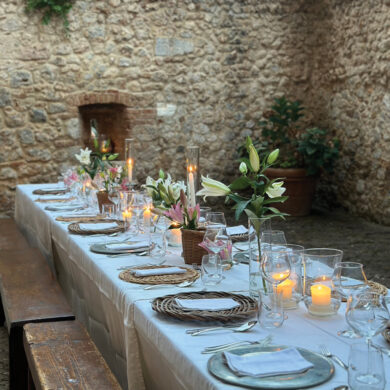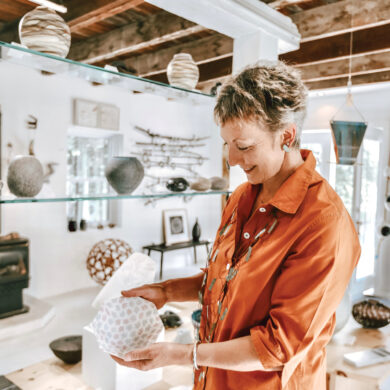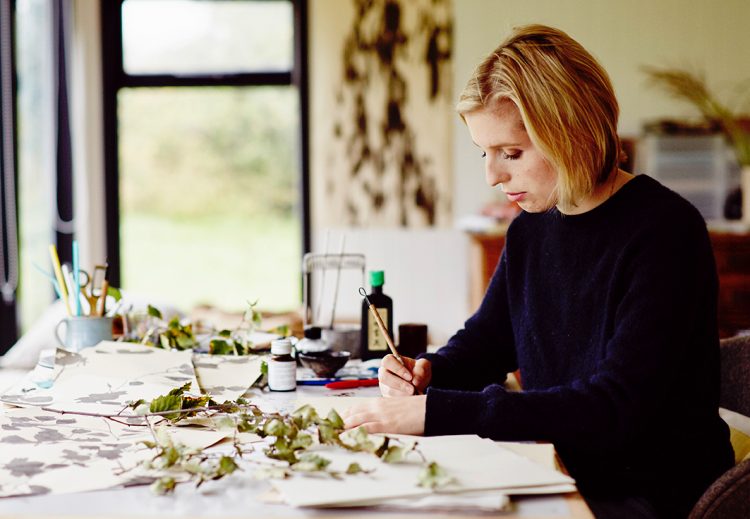
I have learnt to trust my instinct. I studied graphic communications at Bath, with a view of going into editorial design, but following a serious brain trauma, I was forced to take three years out, before completing my degree. Confined to a wheelchair and suffering from seizures, I was worried this was it. My dad encouraged me to help him weed and plant and this gave me hope—igniting an obsessive passion for gardening and desire to paint plants. When I returned to university, I was continuously told that I couldn’t draw and would only succeed by copying. This made me very determined to go against the grain and prove them wrong.
I graduated in 2013 and had my first show in 2014, in San Francisco. The owner of a concept store, Book/Shop in Oakland, spotted my work on Instagram and invited me to show my first collection ‘24 Botanicals’. The launch poster went viral and attracted lots of attention.
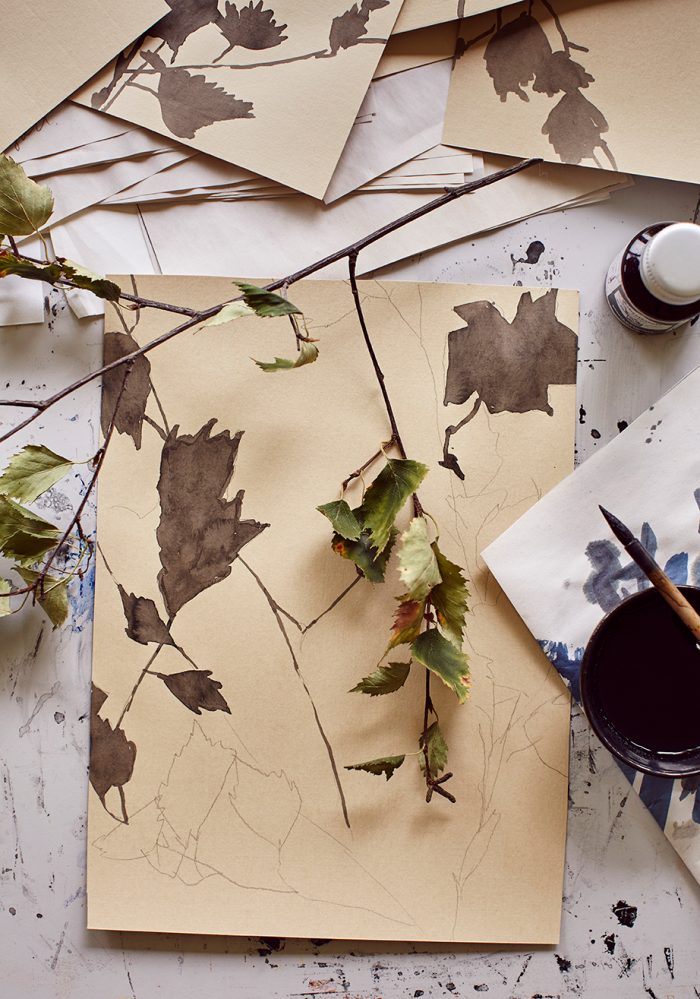
My painting style is instinctive and honest. I forage, photograph and collect specimens—flowers, weeds and plants—and bring them back to my studio to draw as they would be seen in nature. From these sketches, the paintings evolve. I work in the season and then move on. It is very similar to presenting a fashion collection—everything has to be relevant and current. ‘500 Flowers and the Artists Process’ was my first large-scale show of work in Bath in 2015.
They say if you put in 10,000 hours you become a master of what you do. I felt if I could paint 500 flowers I could become a master.
For three months, I worked intensely and by the end, my true style emerged. I invited every contact I had, and on the first day, people were queuing out the door. An editor catapulted my career, showcasing nine paintings for a decorating feature—the collection sold out immediately.
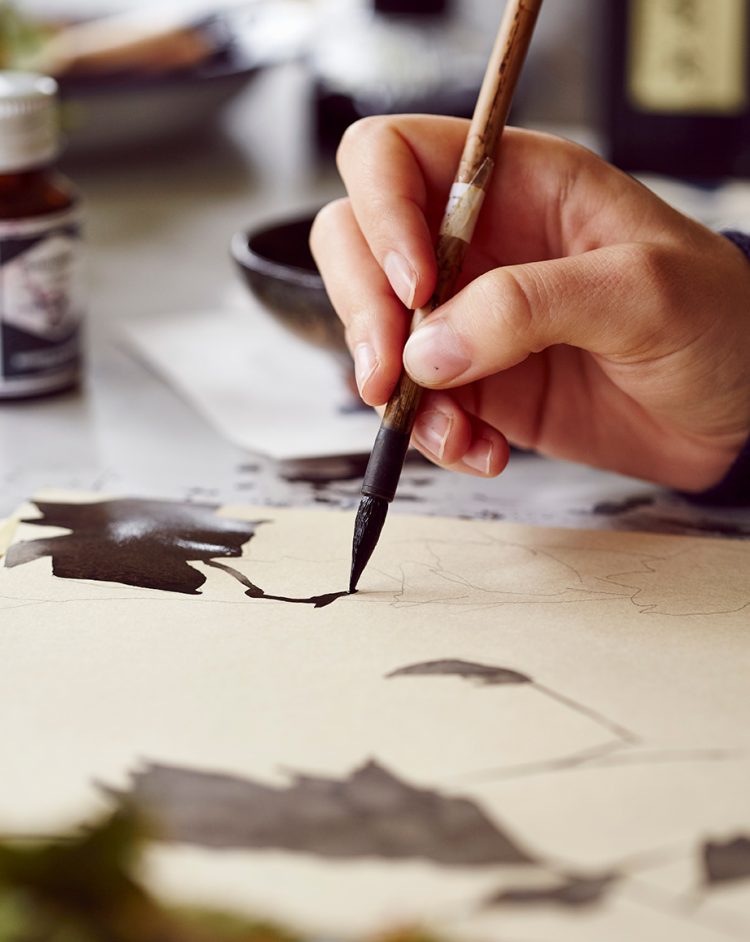
After an exhibition like this or a big block of work, my studio can look like a bomb has hit it, and trying to start from this point can be tricky. So, before I begin to paint again, I clean the studio, empty all the drawers and sort out my paint brushes etc. I need to have everything organised so I don’t later get distracted looking for something.
I paint using a Chinese brush. This now feels so simple and effortless, but it took the whole ‘500 Flowers’ collection to master, as the nib is quite fat. The papers I use are artisan made, and each season, I choose colours and calligraphy inks to reflect the mood.
I have 100s of sketchbooks with ideas and really don’t ever have a problem with creative inspiration; however, when things go wrong in the outside world, from personal life to business life, this sometimes blocks my creativity. It can become really hard to create when you are worried about someone who is sick in your family etc., so I started seeing a therapist to work with this anxiety and get to know myself a little more. Blocks less likely come up now.
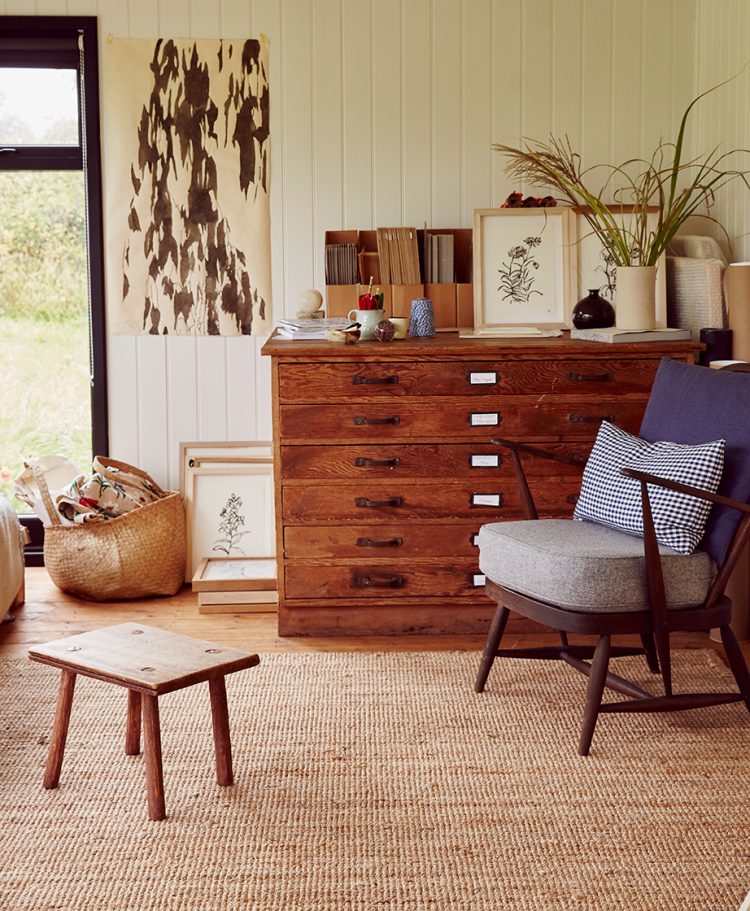
Finding peace in my passion can be a struggle sometimes, as even though art is my passion, it is also my business. So, if I am having a particularly tough week with things going wrong, I do question why I do what I do. I have found that not following other artists and galleries on Instagram has helped so that way I don’t worry about what everyone else is doing. This then leads to my keeping to the mantra:
“to stay in my own lane”
Even if I get people questioning what I am up to (as people will always have an opinion), I know I am on my right path. There is a saying, ‘Health is wealth,’ and I live by this. To practice wellness in my life, I keep up a weekly regime combining Yin yoga, TRE, green smoothies and a home cooked diet. I got really ill in my early 20s so I am one of those people if there is a health craze going around, I will either have done it or will be doing it.
“Look deep into nature, and then you will understand everything better.”
– Albert Einstein
The setting of my studio welcomes mindfulness easily. I am far from town, traffic and people in general so already there is calm when I arrive. My windows look out onto trees and fields so sometimes I just allow my mind to wonder which helps when I need to take the pressure off from deadlines. I only check emails between 7am and 10am and go for an hour walk in the countryside every morning after. This is my mindful pause each day and has become vital for clearing my mind before painting.
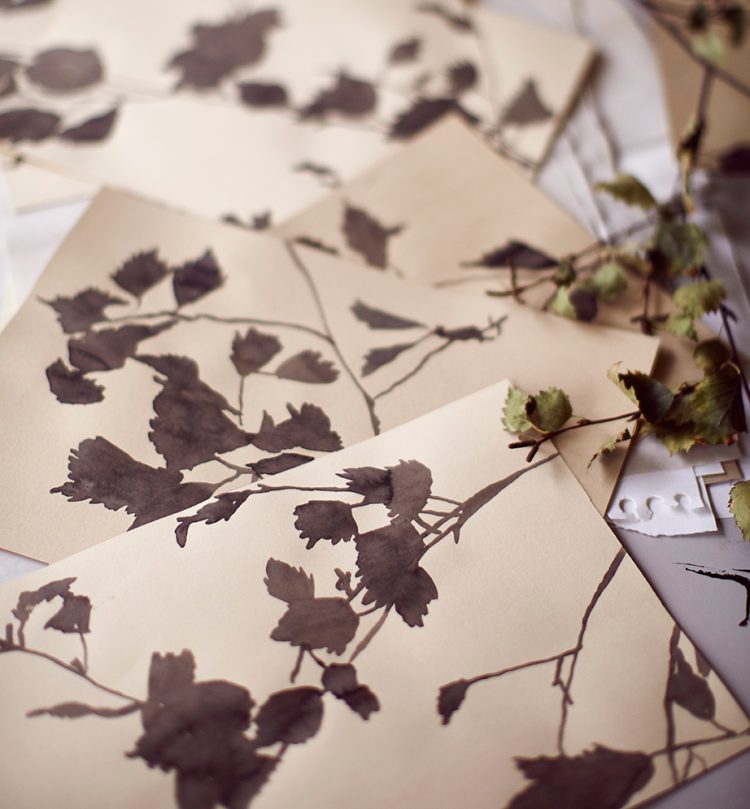
My studio is a Japanese-style summerhouse set amongst open countryside about fifteen minutes from home, on the outskirts of Bath. I bought the studio at The Chelsea Flower Show with every penny I had saved. I was beginning to take on more commissions and felt I had to push myself, or fear never getting to the next level. It is a wonderful place to invite customers and has transformed how I work. The boldness of the black studio exterior is juxtaposed with the simple whitewashed interior. I previously rented a windowless, shared barn, but as my work took off I approached my farmer landlord, Mr. Rittner (now very sadly deceased) and his wife, about renting a field and erecting my current garden building. Firm supporters of my work, they recognised my need to move on and agreed.
My workspace has been called a “zen den,” as I am regularly burning Palo Santo incense and playing the kind of music you’d find in a yoga studio.
I need things to be calm—it’s just what type of an artist I am. I like when clients say my paintings make them feel calm, which is nice, as it means that all these processes I have implemented do have an effect on the final pieces.
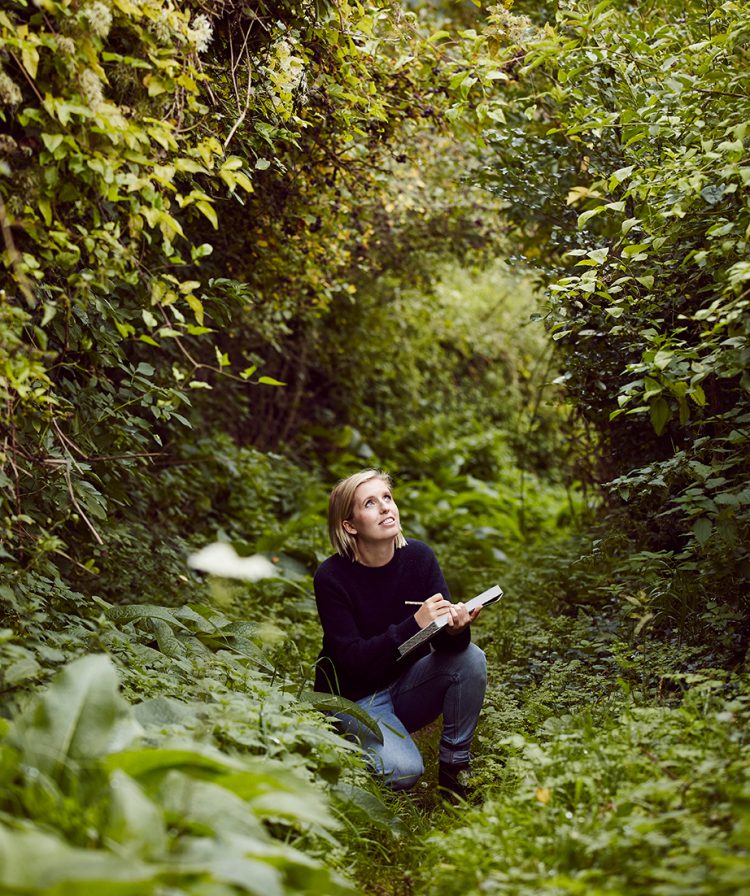
My studio provided the impetus for my new passion—trees. I look out onto ash, walnut and silver birch trees, and my recent ‘Tree Shadows’ collection of work, shown at Botany, documents the changing silhouettes of the branch shadows, falling through my windows. The idea for the collection was triggered one afternoon from seeing shadows of Birch branches that fell onto empty frames on my desk. I would wait for the afternoon light and nature dictated the look. It was often a race against time and by the end of the season, the shadow shapes changed dramatically. The work captures what was felt in very specific moments of time. The ‘Tree Shadows’ collection is very minimal—the work speaks for itself and there is never a hidden meaning.
I have used Sumi ink to paint the ‘Tree Shadows’ collection. The ink has been in production since 1700 and is made using the skins of walnuts when they decompose before being tinted in various colours. It is usually used for calligraphy so is very fluid. In some of the paintings, there is negative space, which some people find uncomfortable. But to me, in life drawing, it has to be real, and space is important.
I have had solo shows in the UK, America and Japan; have been commissioned on packaging and display projects for The White Company, Bamford and Daylesford; and worked with Anthropologie, Gleneagles, The Beaverbrook Estate, Bayntun Flowers and Esme Winter. I sell the majority of my work via my website.
I am constantly editing and refining. I have a new solo show at the Garden Museum (14th June – 22nd July). I go to every garden show, open garden and National Trust property that I can – these living paintings help shape the basis of my work on paper, and I notice every detail. One day I would love to design The Chelsea Flower Show artwork. Gardening and painting have given me a renewed purpose, and I am very grateful to everyone that has supported me.

I have learnt to trust my instinct. I studied graphic communications at Bath, with a view of going into editorial design, but following a serious brain trauma, I was forced to take three years out, before completing my degree. Confined to a wheelchair and suffering from seizures, I was worried this was it. My dad encouraged me to help him weed and plant and this gave me hope—igniting an obsessive passion for gardening and desire to paint plants. When I returned to university, I was continuously told that I couldn’t draw and would only succeed by copying. This made me very determined to go against the grain and prove them wrong.
I graduated in 2013 and had my first show in 2014, in San Francisco. The owner of a concept store, Book/Shop in Oakland, spotted my work on Instagram and invited me to show my first collection ‘24 Botanicals’. The launch poster went viral and attracted lots of attention.

My painting style is instinctive and honest. I forage, photograph and collect specimens—flowers, weeds and plants—and bring them back to my studio to draw as they would be seen in nature. From these sketches, the paintings evolve. I work in the season and then move on. It is very similar to presenting a fashion collection—everything has to be relevant and current. ‘500 Flowers and the Artists Process’ was my first large-scale show of work in Bath in 2015.
They say if you put in 10,000 hours you become a master of what you do. I felt if I could paint 500 flowers I could become a master.
For three months, I worked intensely and by the end, my true style emerged. I invited every contact I had, and on the first day, people were queuing out the door. An editor catapulted my career, showcasing nine paintings for a decorating feature—the collection sold out immediately.

After an exhibition like this or a big block of work, my studio can look like a bomb has hit it, and trying to start from this point can be tricky. So, before I begin to paint again, I clean the studio, empty all the drawers and sort out my paint brushes etc. I need to have everything organised so I don’t later get distracted looking for something.
I paint using a Chinese brush. This now feels so simple and effortless, but it took the whole ‘500 Flowers’ collection to master, as the nib is quite fat. The papers I use are artisan made, and each season, I choose colours and calligraphy inks to reflect the mood.
I have 100s of sketchbooks with ideas and really don’t ever have a problem with creative inspiration; however, when things go wrong in the outside world, from personal life to business life, this sometimes blocks my creativity. It can become really hard to create when you are worried about someone who is sick in your family etc., so I started seeing a therapist to work with this anxiety and get to know myself a little more. Blocks less likely come up now.

Finding peace in my passion can be a struggle sometimes, as even though art is my passion, it is also my business. So, if I am having a particularly tough week with things going wrong, I do question why I do what I do. I have found that not following other artists and galleries on Instagram has helped so that way I don’t worry about what everyone else is doing. This then leads to my keeping to the mantra:
“to stay in my own lane”
Even if I get people questioning what I am up to (as people will always have an opinion), I know I am on my right path. There is a saying, ‘Health is wealth,’ and I live by this. To practice wellness in my life, I keep up a weekly regime combining Yin yoga, TRE, green smoothies and a home cooked diet. I got really ill in my early 20s so I am one of those people if there is a health craze going around, I will either have done it or will be doing it.
“Look deep into nature, and then you will understand everything better.”
– Albert Einstein
The setting of my studio welcomes mindfulness easily. I am far from town, traffic and people in general so already there is calm when I arrive. My windows look out onto trees and fields so sometimes I just allow my mind to wonder which helps when I need to take the pressure off from deadlines. I only check emails between 7am and 10am and go for an hour walk in the countryside every morning after. This is my mindful pause each day and has become vital for clearing my mind before painting.

My studio is a Japanese-style summerhouse set amongst open countryside about fifteen minutes from home, on the outskirts of Bath. I bought the studio at The Chelsea Flower Show with every penny I had saved. I was beginning to take on more commissions and felt I had to push myself, or fear never getting to the next level. It is a wonderful place to invite customers and has transformed how I work. The boldness of the black studio exterior is juxtaposed with the simple whitewashed interior. I previously rented a windowless, shared barn, but as my work took off I approached my farmer landlord, Mr. Rittner (now very sadly deceased) and his wife, about renting a field and erecting my current garden building. Firm supporters of my work, they recognised my need to move on and agreed.
My workspace has been called a “zen den,” as I am regularly burning Palo Santo incense and playing the kind of music you’d find in a yoga studio.
I need things to be calm—it’s just what type of an artist I am. I like when clients say my paintings make them feel calm, which is nice, as it means that all these processes I have implemented do have an effect on the final pieces.

My studio provided the impetus for my new passion—trees. I look out onto ash, walnut and silver birch trees, and my recent ‘Tree Shadows’ collection of work, shown at Botany, documents the changing silhouettes of the branch shadows, falling through my windows. The idea for the collection was triggered one afternoon from seeing shadows of Birch branches that fell onto empty frames on my desk. I would wait for the afternoon light and nature dictated the look. It was often a race against time and by the end of the season, the shadow shapes changed dramatically. The work captures what was felt in very specific moments of time. The ‘Tree Shadows’ collection is very minimal—the work speaks for itself and there is never a hidden meaning.
I have used Sumi ink to paint the ‘Tree Shadows’ collection. The ink has been in production since 1700 and is made using the skins of walnuts when they decompose before being tinted in various colours. It is usually used for calligraphy so is very fluid. In some of the paintings, there is negative space, which some people find uncomfortable. But to me, in life drawing, it has to be real, and space is important.
I have had solo shows in the UK, America and Japan; have been commissioned on packaging and display projects for The White Company, Bamford and Daylesford; and worked with Anthropologie, Gleneagles, The Beaverbrook Estate, Bayntun Flowers and Esme Winter. I sell the majority of my work via my website.
I am constantly editing and refining. I have a new solo show at the Garden Museum (14th June – 22nd July). I go to every garden show, open garden and National Trust property that I can – these living paintings help shape the basis of my work on paper, and I notice every detail. One day I would love to design The Chelsea Flower Show artwork. Gardening and painting have given me a renewed purpose, and I am very grateful to everyone that has supported me.







